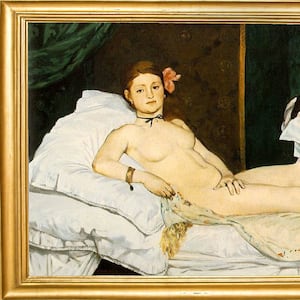PARIS—From the time that Édouard Manet first met Berthe Morisot in 1868, when he was 36 and she was 27, he had trouble coming to terms with her eyes. They were, wrote the poet Paul Valéry, “almost too vast, and so powerfully obscure that Manet in the many portraits that he made of her, to try to capture all of their shadowed, magnetic force, painted them as black rather than green, as they were. The pupils replaced the retinas.”
If you have ever admired Manet’s work, you have seen that face and those eyes. She is the woman with a fan on a balcony, looking down at we know not what, perhaps inside herself. She reclines on a sofa, all in virginal white in one canvas, or in black with a black ribbon around her throat in another. Countless books and articles dealing with Manet have been graced with her face framed by a high, rather improbable hat in “Berthe Morisot with a Bouquet of Violets.” And always you look at her eyes, and often they are looking into you.
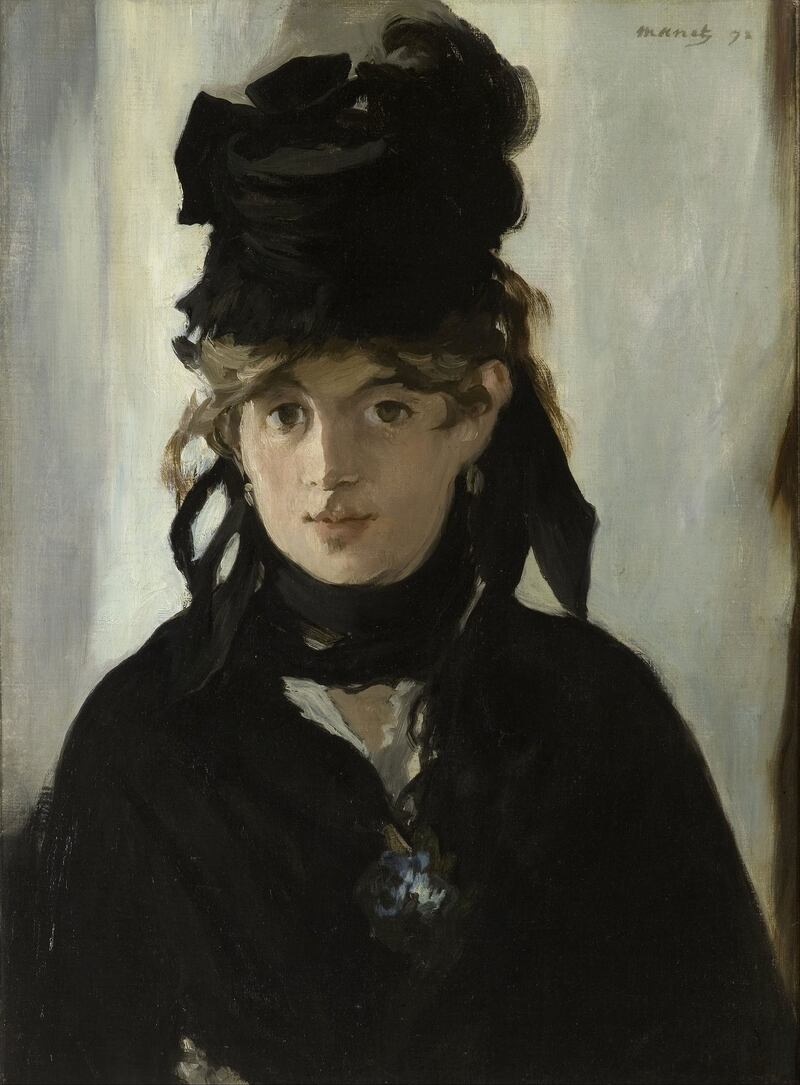
How fascinating it must have been to be with the two of them in Manet’s studio near the Place de Clichy when they first met and she first posed. He was the bad boy of the Academy—whose picnicking nudes in “Déjeuner sur l’herbe” and naked, challenging courtesan awaiting her client in “Olympia” already had scandalized the art world. Morisot was this demure, inscrutable young woman with the striking eyes, who was accompanied by her mother as chaperone.
ADVERTISEMENT
If their encounter was to be an exercise in physical seduction on Manet’s part, as he probably hoped, by all accounts it failed, and the chaperone was the least of it. The two of them simply had very different visions of society, of life, and most importantly of art.
Both Manet and Morisot were from the ascendant upper middle class of the time, la grande bourgeoisie. They did not live or work in the garrets of Montmartre or the Latin Quarter, but in the burgeoning new buildings of the 16th and 17th arrondissements on the Right Bank, made of solid stone cut and carved to stolid perfection like those that would be associated later in the century with what is called La Belle Époque.
Their circles of friends overlapped: among the painters, Edgar Dégas; among other notables the novelist Émile Zola and the poet Charles Baudelaire—who would join the Manet brothers and the Morisot sisters at dinners hosted by the Morisot family at their home on Rue Franklin in the heart of the 16th on the heights above the Seine River.
Both Manet and Morisot were rebels but, again, in very different ways. Manet provoked with canvases like “Déjeuner” and “Olympia,” while still remaining in the orbit of the Académie des Beaux-Arts with its yearly Salon for French artists who received recognition from the public and medals and money from the state, which bought many of their works. Like Gustave Courbet before him (painter of that pubic epic “L’Origine du Monde”), Manet could build his notoriety on both the acceptance and the rejection of the Academy’s judges. But the Academy was always the point of reference.
Morisot rebelled quietly and resolutely at first by insisting that she, a woman, be taken seriously as an artist. Her two older sisters had married and one of them, Edma, was an accomplished painter as well, but Edma gave up the palette and brush when she moved with her new husband to the Breton coast.
This was the expectation of the times: women might learn to play musical instruments and how to draw, they might even be good at it, but those were mere social ornaments. Manet himself wrote of Edma and Berthe, “The young ladies are charming. It’s unfortunate they’re not men. Nevertheless they could, as women, serve the cause of painting by marrying a member of the Academy.”
Berthe was approaching 30 and sure spinsterhood by the standards of her class. But Berthe was not much interested in men, or for that matter in women apart from her sisters. She was all about the work, the light, the color, the experimentation with brushstrokes. She had exhibited several times at the Academy, but in 1874, while still posing occasionally for Manet, and learning from his technique—but against his advice—she joined with about 30 other artists, all of them men, in a concerted rebellion against the artistic norms of the day.
They were called, at first derisively, later with pride, “Impressionists.”
At the grand retrospective of Morisot’s work on show here at the Musée d’Orsay until Sept. 22, one can begin to appreciate (while elbowing through the crowds) how interesting and enigmatic her painting was for its time, and how especially striking it is in contrast to Manet’s.
Not a single subject painted by Morisot is calculated to evoke outrage, or even surprise as a subject in itself. She painted many picnics, but of women and children unprovocatively at peace in one park or another. Her nudes are in the studio as models, not as objects of desire or provocation or, much less, as the quasi-pornographic fantasies common at the Academy.
One of the most interesting Morisot canvases showing bare skin is not even a nude, but the shoulder of a fully dressed woman fixing her hair in front of a mirror. Her face is unseen, but the canvas is full of expression because of the color and the brush strokes and movement, over which Morisot labored for five years.
Perhaps her most famous work is “Le Berceau,” a woman (her sister Edma) looking at a baby (her niece) in a crib with a veil of mousseline draped over it.
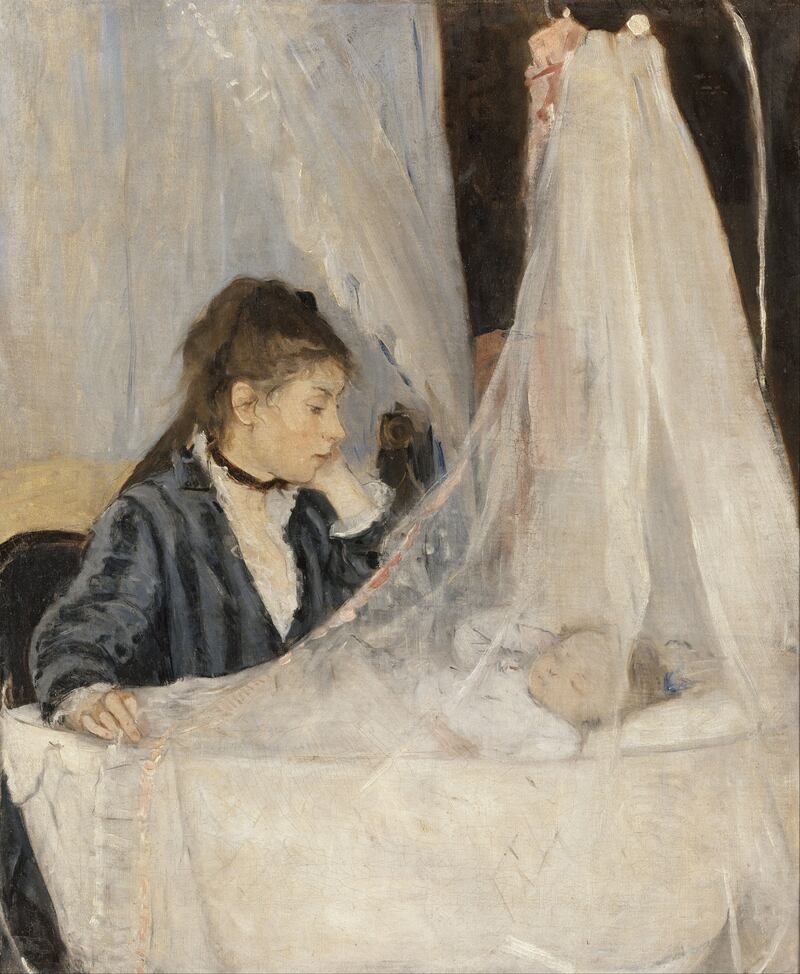
Eventually, at her mother’s insistence, Morisot did get married at the late age of 36 to Édouard Manet’s dilettante brother Eugène, and she was a devoted mother to their daughter Julie, who also became one of her frequent subjects. Occasionally Eugène shows up in the park with Julie, and those paintings could be taken as depictions of blissful domesticity. But of course that is not what they were about.
In fact they were about the paint itself and what it can do, the ability of art to touch you, not because of the subject but apart from it. Do we love Claude Monet’s water lilies as such? Or his haystacks as haystacks? The interest of Impressionism in its essence is independent of its subjects, which is one reason Manet was not an Impressionist, and Morisot was.
Still, we philistines are always intrigued by the content of representational art, and after visiting the show at the Orsay, I was curious to see what I could find of Berthe Morisot’s Paris in the 16th arrondissement, which is still a very haute bourgeois part of town.
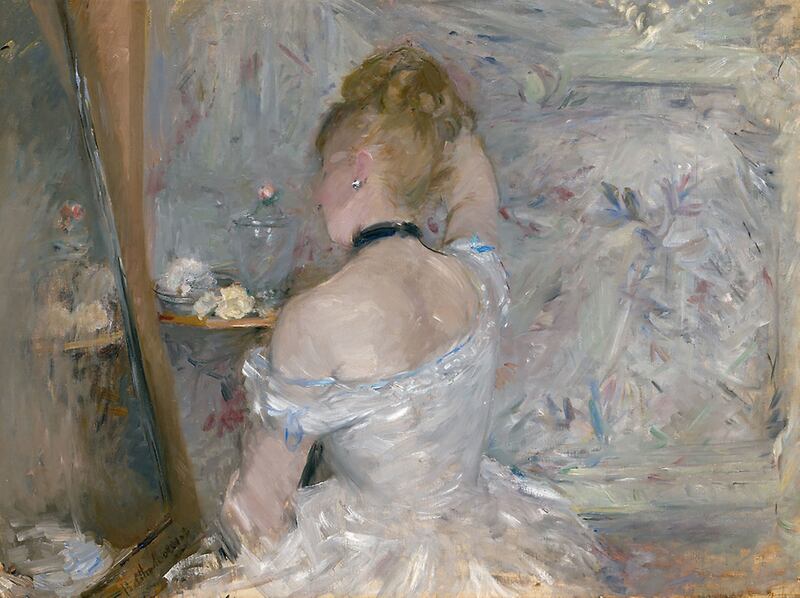
I visited several of the addresses where she lived and worked, but most were rather disappointing, the buildings torn down and replaced by ugly institutional glass and steel in some places, or Belle Époque edifices constructed a bit later than her residences. On a street near the Arc de Triomphe is a house she built in 1883 that became the center of her family’s world, including the poet Paul Valéry, who had married her niece. Today, the street is named for him.
One structure that probably dates to Morisot’s early years is at 35 rue Scheffer (formerly rue des Moulins) where she first learned serious technique from a forgotten artist named Joseph Guichard. The building was nondescript then and is nondescript now, but in a bit of ironic dissonance is home to a designer of rather bizarre modern furniture. In the window: a large gorilla made of shiny silver beads.
So, regrouping, I decided my main point of reference for the Morisot walkabout would be the scene of one of her most famous early paintings, “Woman and Child on the Balcony,” which was first a watercolor, then an oil finished around 1872.
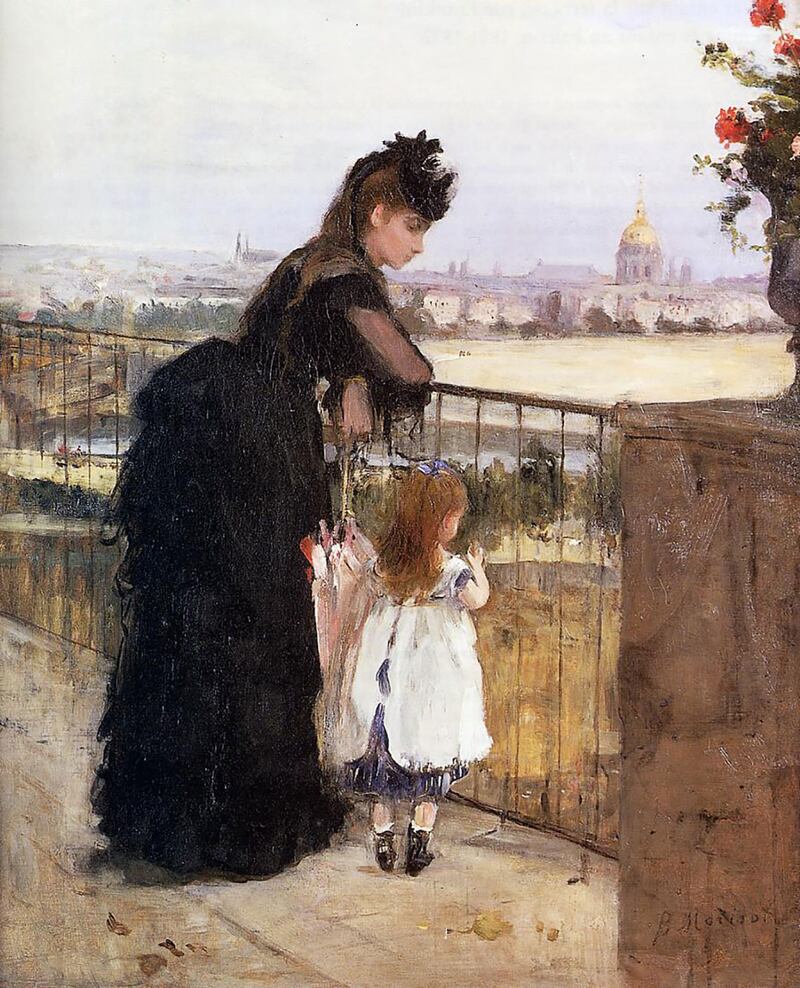
Morisot had been anxious to escape the confines of the studio and to paint in the open air. But her paintings in parks, “sur l’herbe,” as it were, do not have identifiable landmarks. Some are not even in Paris, others may be somewhere in the vast Bois de Boulogne on the edge of the 16th.
In this canvas, however, the woman and a very little girl are looking out over the Seine with the gilded dome of Les Invalides in the distance and an assortment of steeples that might be found today, so I thought it could be possible to vector in on the venue for the painting.
Of course, the first thing that one notices in the present is what’s completely missing from that canvas: the Eiffel Tower, which was not erected until 1889, and the fascistic architecture of the Palais de Chaillot museums at Trocadéro, which would not be built until the 1930s. The ensemble is the epicenter of tourist Paris but, while Morisot lived until 1895 and saw the tower, it never figured in her vision of the city.
By holding up a copy of the painting of the woman and child at the balcony and moving around the terraces at Trocadéro, I finally found the same perspective, and suddenly realized I could line it up almost as if I had a surveyor’s theodolite.
There are normally two domes on that horizon. Indeed, in another Morisot painting from the heights of Trocadéro, you see them both: Les Invalides, and behind it, the Panthéon. But in “Woman and Child on the Balcony,” there is only Les Invalides, because the Panthéon is directly behind it. If you line them up that way and draw a straight line on the map it will take you to the railing on Rue Franklin. Unfortunately, today the only view there is the exterior wall of the largely neglected Musée de l’Homme at the Palais de Chaillot. But as I stood there I realized the scene in Morisot’s day was less than five minutes from where she was living with her family.
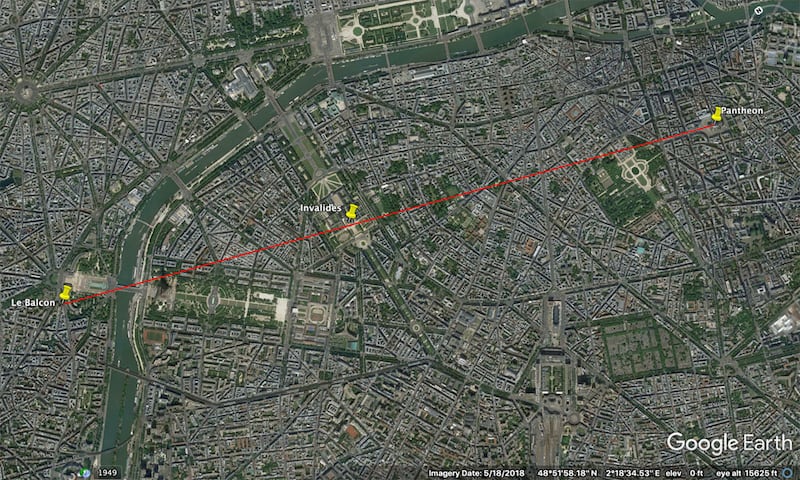
Another site deep in the 16th is more rewarding for a casual visitors. It has an ironic history, and anyone interested in art, tourist or Parisian, should find the time to visit the Musée Marmottan Monet.
Its very bourgeois namesake Paul Marmottan, who bequeathed the building and his personal collection to, yes, the Académie des Beaux-Arts, absolutely loathed everything Berthe Morisot and the Impressionists represented: “One does not draw, one sketches; one does not paint, one brushes. That is the most prominent tendency of the day,” he wrote in 1886. “This slackening comes above all from extreme ignorance or the indulgence of art lovers, who are happy to look merely for the impression.”
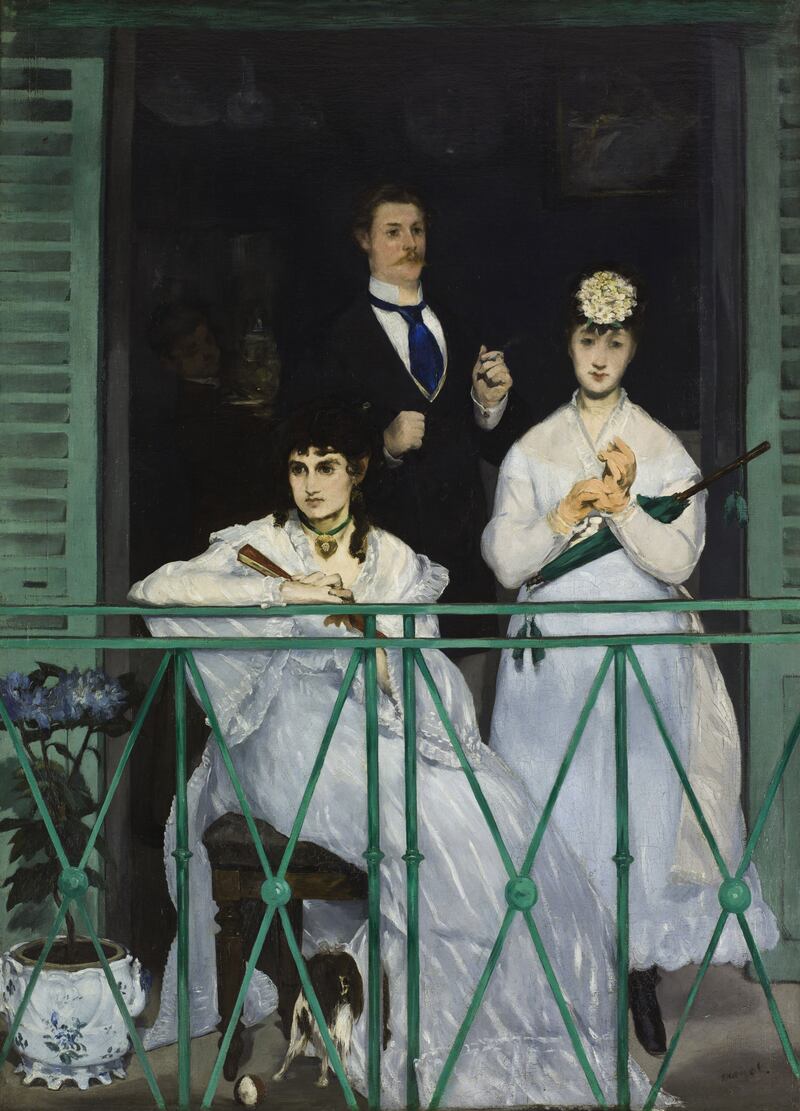
But in the decades following Monsieur Marmottan’s demise, the heirs of the Impressionists, of Morisot and Monet and others, gave scores of priceless masterpieces to the Academy and thence to the Marmottan Museum, making it by the 1950s a Mecca for lovers of their work.
So, when the Morisot show closes at the Orsay toward the end of September, the Marmottan will be the place to go to discover the genius that lay behind the shadowed, magnetic eyes of an extraordinary woman who lived, as it happened, right in the neighborhood.


